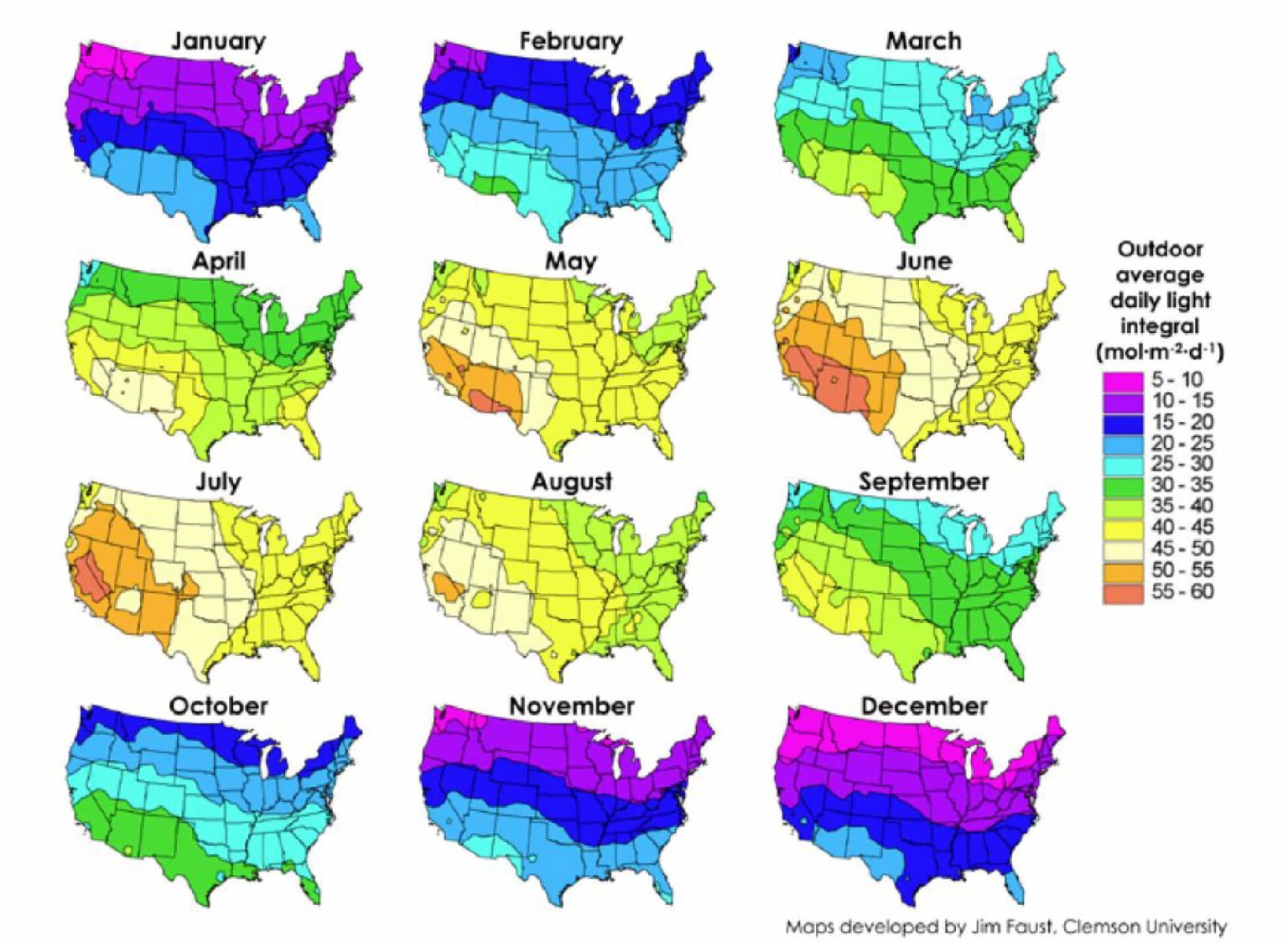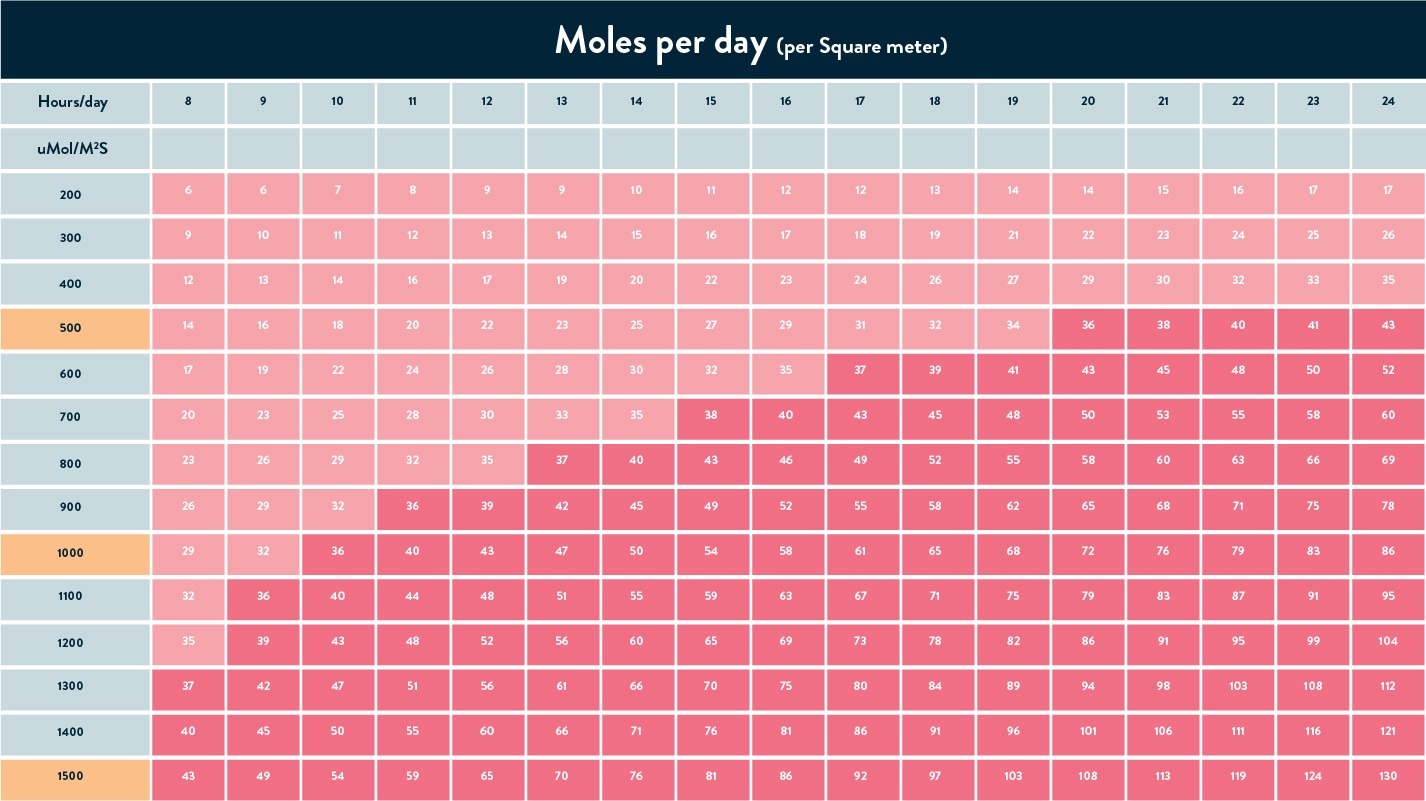Light is a plant’s food. It is imperative that cultivators monitor the amount and type of food their plants receive, just as a nutritionist must monitor what an athlete eats. Each day there is a minimum amount of sunlight required for a plant to receive its basic biological needs. The most common metric for this is Daily Light Integral (DLI), a measure of the cumulative amount of PAR (photosynthetically active radiation) light energy that a surface receives over the course of a day. This measurement helps cultivators determine how much light is available for their plants, expressed as a Moles per Day value.
Enter any two values to calculate the third:

Values in light pink represent typical target DLI amounts
500 uMole represents a typical desirable light intensity for indoor early stage growth.
1000 uMole is a high level intensity for both indoor and greenhouse supplemental lighting for late stage and flowering growth.
1500 uMole is a typical plant saturation level for high DLI crops.
2000 uMole is a typical maximum natural sun output on a clear day.
Daily light integral is one of the most crucial factors in horticulture for consistent crop growth and quality yields. That’s why a DLI calculator is one of the most useful tools in any grower’s arsenal. In particular, a grow light calculator can help determine three variables: light quality, intensity, and photoperiod.
Intensity refers to the amount of light reaching the plant per square meter in one second. This variable can affect VSD levels and thus affect CO2 and water absorption.
Light quality refers to the light spectrum that’s hitting the plants. Together with light intensity, these two variables affect the plant’s temperature and VSD levels.
Lastly, photoperiod is the average length per day the plants are exposed to light, measured in hours.
When these three are entered into a light level calculator, the result is the actual DLI levels. Growers can use this as a baseline to determine whether more or less light is needed.
1500 uMole is a typical plant saturation level for high DLI crops.
2000 uMole is a typical maximum natural sun output on a clear day.
Photosynthetic Photon Flux Density (PFFD) measures light’s intensity or the number of photons in a given amount of light. The unit used is micromoles per meter squared per second, or umol/m2/s. PFFD is crucial for plants because each species has an optimal level for efficient growth.
PFFD is an essential factor if you’re buying grow lights, as it tells you how much intensity it gives out. Combined with the length of exposure (or photoperiods), you can accurately control how much DLI your plants are experiencing.
A DLI calculator will require both PFFD and photoperiods (in hours) as input. Then, based on a given grow light, you can play around with these two variables to regulate your DLI levels.
For example, you can expose your plants twice as long if your grow light isn’t as intense. Conversely, if you get a grow light with double the intensity, you can essentially halve the exposure time and still get the same DLI.
Because of the significant effect PFFD has on DLI, light intensity should be your primary consideration when buying grow lights.
Before purchasing, you can determine the proper PFFD levels you need by playing around with a grow room lighting calculator. Input different PFFD values based on your ideal exposure length until you arrive at optimal DLI levels. When in doubt and budget permitting, it’s better to buy lights at a higher intensity, as it’s relatively easy to reduce them. If you need help finding the right LED grow lights for your harvest or if you have questions about the DLI calculator, contact Scynce LED today.

123 Main Street
New York, NY 10001
©2024 ScynceLED All Rights Reserved | Privacy Policy